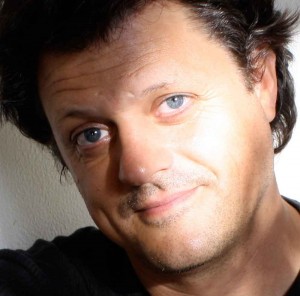I first witnessed the magnetic approach to depression treatment in 2010, when I walked into a nondescript San Antonio clinic and found a golf-shirted man with a football player’s physique flirting with a Skittles-chewing lab tech.
Then in his sixth week of treatment with transcranial magnetic stimulation, or TMS, “Jay” told me he had been struck by a bolt of anxiety so powerful and inexplicable a quarter-century earlier that he thought he was having a heart attack. At the ER, however, the college student was told that he was simply stressed out. He went home, but the panic attacks didn’t stop.

“I ended up just going through and grinning and bearing it,” he said. He started having difficulty concentrating. His memory weakened. He obsessed over his deteriorating condition to the point that the undiagnosed anxiety disorder mutated into deep-seated depression. The only thing that kept him going was his belief that science would one day figure things out, that someone would invent a way out of his torment.
For him, that day arrived in December 2008, when the U.S. Food and Drug Administration “cleared” Neuronetics’ NeuroStar TMS device for medical use. The device was pitched as a safer, if less effective, alternative to electroconvulsive therapy. The FDA panel cleared the device for use mainly because of its lack of serious side effects rather than its “marginal” demonstrated effectiveness.
The health wing of the D.C.-based advocacy group Public Citizen protested the decision, suggesting that even the alleged marginal level of effectiveness had been achieved by manipulating the data. “It is concerning that FDA has cleared this device,” the team wrote, “particularly if patients are diverted from effective therapies such as antidepressant medications.”
Given the findings of the Star-D study, however, it wasn’t a time to turn away even marginally effective alternatives.
Regardless, there were believers like Jay, who told me that after only his second treatment, TMS broke through his emotional dead zone and gave him a momentary glimpse of “normal” emotion for the first time in years. After more than a month of daily magnetic treatments, the man who estimated he had taken 15 different medications battling his entrenched illness called TMS a “miracle,” a “cure.” It was a testimony I wouldn’t soon forget.
********
When my own health deteriorated in 2012 and electroshock was urged, I made up my mind to first try TMS. The trouble was the cost. My insurance provider, Aetna, refused to cover the treatment, calling it “experimental and investigational.” The quoted price of $500 per session (multiply that by an estimated 30 sessions, as is typically recommended) had me swooning, even as the woman on the other end of the line said cheerfully, “We do offer financing.”
I started looking for medical trials involving TMS that I might be able to participate in without cost. That’s when I discovered NeoSync’s “egg” and what may become the latest magnet-based depression therapy to enter the mental-health market.
The magnetic devices manufactured by groups like NeoSync, Neuronetics, and Brainsway are part of the movement away from purely biochemical treatment options for depression. They also represent a growing acceptance of fundamental principles informing many traditional healing systems.
First to the market, the NeuroStar TMS device releases 3,000 pulses of electromagnetic energy per treatment session that generate an extremely weak electric current about an inch inside the left frontal portion of the brain. Those currents have been shown to increase blood flow, elevate metabolic processes (including the production of glucose), and re-engage neurons. And the promise of TMS appears to be growing as methods of delivery are tweaked.
A 2012 study led by Dr. Linda Carpenter, chief of the Mood Disorders Program and the Neuromodulation Clinic at Butler Hospital, surveyed 307 clients at 42 clinical TMS therapy sites and reported an overall positive response rate of 58 percent among those who had been unable to benefit from previous antidepressant treatment; 37 percent achieved full remission. In a follow-up study presented at the annual meeting of the American Psychiatric Association in San Francisco earlier this year, Carpenter reported that 68 percent of patients observed 12 months after treatment with four to six weeks of daily TMS and continued anti-depressant treatment showed “significant improvement,” and 45 percent were in full remission.
Marilyn Vaché at the Austin TMS Clinic for Depression said her results have been even better. “At least 65 percent have had that significant improvement. That means if they started out with severe [depression], they went down to mild. If they started out with moderate to mild, they went down to remission. Fifty-one percent were in the remission category,” she said.
Konyecsni, who started offering TMS at his psychiatric practice only about a year ago, said all eight of his adult patients have achieved remission.
********
Martha Rhodes first received TMS treatment in 2010. Like me, the former New York City ad executive had suffered for decades, done poorly on a range of pharmaceuticals, and shied away from electroconvulsive therapy. She was desperate for something outside psychiatry’s traditional toolbox when her sister faxed her a full-page ad from Connecticut Magazine trumpeting the “newest technology to treat depression without discomfort or drugs.”
TMS took three weeks to start pulling Rhodes out of her death-wish depression, although she suffered a dangerous mood dip in week two. “Your brain is being reconnoitered,” Rhodes told me. “You could experience happiness, then sadness, then happiness again. It takes, I’m going to say, a good 20 visits.” She has since written two books on her experience with TMS.
Researchers for years have been examining TMS for its ability to aid in the treatment of Parkinson’s, tinnitus, schizophrenia, and the recovery from stroke symptoms. When I dug into the literature, I found that magnetic fields are foundational to both the geophysical and the biological.
Life evolved in Earth’s reliable field of eight pulses per second, and everything from antibiotic treatment to cellular healing and mental regeneration has been shown to be influenced by them. Electromagnetic fluctuations from the sun have proved to have real impacts on our health. Validating theories of that 18th-century healer and proponent of “animal magnetism” Franz Mesmer, researchers have been able to link sunspot activity disrupting our natural geomagnetic field with increased rates of psychotic behavior and institutionalization.
I have questions about the trial at the University of Texas-Southwestern Medical Center that I participated in. Regrettably, NeoSync chose not to participate in this story. The state attorney general’s office ruled that UT–Southwestern was not required by state open-records law to release records on the study’s specifics.
********
In Dallas, in my dim room, I drifted through multiple levels of awareness as the egg did its thing. We were in the fourth week of the trial.
Out of the darkness and the day’s troubled thoughts I felt a moth fluttering against my right ear and cheek. Would I break protocol if I swiped after it? Opened my eyes? I mentally tracked the fluttering for what felt like minutes. Velvet wings brushed against the invisible hairs above the earlobe, and almost imperceptible insect steps moved along the ear’s ridge before the fluttering sensation resumed again. It dawned on me how unlikely it was that a moth would be haunting the research hospital testing room.
Was this nerves activating? I focused again and observed a slender pain move through the inside of my cheek. Felt another energetic tentacle spread behind my eye. The electrical stimuli around my head and face suggested I was not getting the placebo treatment. At the same time, a surge of sadness –– brought on by my inability to get insurance due to my mental-health history –– also meant that even a cutting-edge depression-buster wasn’t an automatic happy pill.
In those first weeks, I’d gone through days of high agitation, suffered a multi-day migraine, and started having trouble sleeping –– all things the attending doctor warned I might experience. But I’d also discovered newfound physical energy and a noticeably sharpened mental acuity that allowed me to steam through book after book on psychology, psychiatry, electromagnetism, religion, and shamanism.
“The stuff is happening,” I wrote at the time. “I’m sure it’s the device.”
My energetic rush, a generative vitality I hadn’t felt in many years, continued for about two months post-treatment. In my first two weeks back in San Antonio, I set up a home office, fixed a collapsed wall shelf and assembled a floor shelf for my daughter’s room, got caught up on all my bills, patched my windshield and changed my oil, did the laundry, got my hair cut, swept and mopped the house twice. The list goes on. I was functioning on a level vastly higher than I had been before treatment — still without drugs.
I came out in far better shape than I went in. But there has been a retrenchment of late, a slow return of brooding and ambivalence. John Carnuccio, CEO of NeoSync, acknowledged that the duration of the TMS treatment’s benefits is still uncertain.
Rhodes suffered a relapse but pulled out with 10 additional treatments. She now receives TMS twice a month for maintenance, she said. She’s not an anomaly.
“Based on my experience, there’s probably a third of people who will relapse and need additional treatments,” Vaché told me. “If we catch them early, we can sometimes get them back with three to 15 treatments.”
Given that depression tends to be a “lifelong” condition, Carnuccio said he hopes that eventually people will be able to check out one of his company’s device from their doctor’s offices for self-administered daily home treatments.
“It’s a pretty simple device,” he said. “That’s our objective.”
In an interesting twist, many trial participants developed the need for traditional therapy during the NeoSync trial in Dallas, some for the first time. “Because they have all these new emotions bubbling up,” the doctor with curls told me, waggling her fingers in the air. “Drugs and this [gesturing to the egg] can’t do everything.”
From the couch, I pine for the coming reforms of the Affordable Care Act that will force the insurance companies to accept people like me, people whose health and health troubles “pre-exist.” While Vaché said some of her clients have been able to get their insurance providers to cover their TMS treatments, they’re in the minority, and the compensation rates remain far from adequate to cover the costs of the treatments.
The egg and the growing number of devices like it do quite a lot, I’ve found out.
At least most of the time. For a while.
Greg Harman is an independent journalist and longtime environmental reporter based in San Antonio, Texas. His environmental work can be seen at harmanonearth.com, and his writings on depression are available at depression-time.com.












I hope foremost that you are feeling better. Secondly I would like to tell you that for all of the lovely things that bioenergetics can do, there is the opposite extreme which can also be created using this technology when TMS electrodes are implanted. Not only can depression be cured with tihs technology, it can be created. Like your computer, your brain can be hacked with TMS implants. Like a human RFID tag, your thoughts in the form of eeg readings can be captured by cellphone and translated into readable phrases. Additionally, you can be rendered unconscious and/or sleep deprived. Every nerve in your body can be controlled by your hacker and his buddies and then their buddies and so on. Pain becomes the norm.
Freedomfchs is a website where thousands of people meet to discuss what appears to be a very large nonconsennsual experiment in social control with this same or similar technlogy. The Psychiatric industry is a greater than 300 billion dollar industry. As you said, must be something in the water, and remember that nanotech can’t be seen with a hospital microscope but requires electron microscopy not standard in hospitals. We can’t all be crazy and yet we’re certainly being painted to look that way.
I hope foremost that you are feeling better. Secondly I would like to tell you that for all of the lovely things that bioenergetics can do, there is the opposite extreme which can also be created using this technology when TMS electrodes are implanted. Not only can depression be cured with tihs technology, it can be created. Like your computer, your brain can be hacked with TMS implants. Like a human RFID tag, your thoughts in the form of eeg readings can be captured by cellphone and translated into readable phrases. Additionally, you can be rendered unconscious and/or sleep deprived. Every nerve in your body can be controlled by your hacker and his buddies and then their buddies pand so on. Pain becomes the norm.
Freedomfchs is a website where thousands of people meet to discuss what appears to be a very large nonconsennsual experiment in social control with this same or similar technlogy. The Psychiatric industry is a greater than 300 billion dollar industry. As you said, must be something in the water, and remember that nanotech can’t be seen with a hospitalized microscope but requires electron microscopy not standard in hospitals. We can’t all be crazy and yet we’re certainly being painted to look that way.
I hope foremost that you are feeling better. Secondly I would like to tell you that for all of the lovely things that bioenergetics can do, there is the opposite extreme which can also be created using this technology when TMS electrodes are implanted. Not only can depression be cured with tihs technology, it can be created. Like your computer, your brain can be hacked with TMS implants. Like a human RFID tag, your thoughts in the form of eeg readings can be captured by cellphone and translated into readable phrases. Additionally, you can be rendered unconscious and/or sleep deprived. Every nerve in your body can be controlled by your hacker and his buddies and then their buddies pand so on. Pain becomes the norm.
Freedomfchs is a website where thousands of people meet to discuss what appears to be a very large nonconsennsual experiment in social control with this same or similar technlogy. As you said, must be something in the water, and remember that nanotech can’t be seen with a hospitalized microscope but requires electron microscopy not standard in hospitals. We can’t all be crazy and yet we’re certainly being painted to look that way.